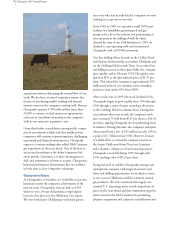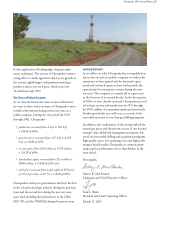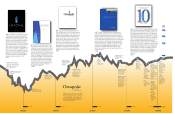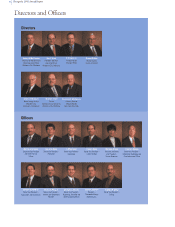Chesapeake Energy 2002 Annual Report Download - page 6
Download and view the complete annual report
Please find page 6 of the 2002 Chesapeake Energy annual report below. You can navigate through the pages in the report by either clicking on the pages listed below, or by using the keyword search tool below to find specific information within the annual report.
acquisitions without disrupting the normal flow of our
work. We also have a team of acquisition experts that
focuses on purchasing smaller working and mineral
interest owners in the company’s existing wells. Because
Chesapeake operates 5,700 wells and has more than
33,000 co-owners, we find numerous opportunities
each year to consolidate ownership in the company’s
wells at very attractive acquisition costs.
Given that further consolidation among public compa-
nies in our industry is likely and that smaller private
companies will continue experiencing more challenging
operational and financial environments, Chesapeake
expects to continue making value-added Mid-Continent
gas acquisitions in the years ahead. One of the keys to
success in this industry is the ability to generate bal-
anced growth. Sometimes it is more advantageous to
drill, and sometimes it is better to acquire. Chesapeake’s
historical performance demonstrates that its excellence
in both areas is a key competitive advantage.
Chesapeake’s History
As Chesapeake’s co-founders, we would like to put into
historical context the company’s achievements of the
past ten years. Chesapeake’s roots go back to 1983
when we were 24-year-old landmen competing for
leases in a hot play near the Oklahoma City airport.
We were both native Oklahomans with third genera-
tion roots who had recently left the companies we were
working for to go out on our own.
From 1983 to 1989, we operated a small 50/50 part-
nership on a handshake, generating oil and gas
prospects for sale to the industry and participating as
non-operators in the drilling of wells by others.
Around the time of our 30th birthdays in 1989, we
decided to start operating wells and incorporated
Chesapeake with a $50,000 investment.
Our first drilling efforts focused on the Golden Trend
and Sholem Alechem fields in southern Oklahoma and
on the Giddings field in south Texas. As a result of ini-
tial drilling successes in these three fields, the company
grew quickly, and in February 1993 Chesapeake com-
pleted its IPO at the split-adjusted price of $1.33 per
share. This valued the company at approximately $70
million and reduced our common stock ownership
position to just under 60% from 100%.
After a rocky start in 1993 (the stock declined 65%),
Chesapeake began to grow rapidly from 1994 through
1996 through a series of major natural gas discoveries
in the Giddings Field in southeast Texas. During this
extraordinary three-year period, the company’s stock
price increased 73-fold from $0.47 per share to $34.44
per share, making Chesapeake the #1 performing stock
in America. During this time, the company’s enterprise
value soared from a low of $35 million in early 1994 to
a peak of $2.7 billion in late 1996. However, because
of a failed effort to extend the company’s success in
the Austin Chalk trend from Texas into Louisiana
and a dramatic collapse in oil and natural gas prices,
Chesapeake’s stock fell during 1997 through early
1999 reaching a low of $0.63 per share.
Facing the need to redefine Chesapeake’s strategy and
underpin the company with longer-lived assets and
lower-risk drilling opportunities, we decided to return
to our roots in Oklahoma as Mid-Continent natural
gas producers. We were convinced that supply-con-
strained U.S. natural gas prices would outperform oil
prices in the years ahead and that tremendous opportu-
nities existed in the Mid-Continent for producing
property acquisitions and corporate consolidations and
Chesapeake 2002 Annual Report
4















